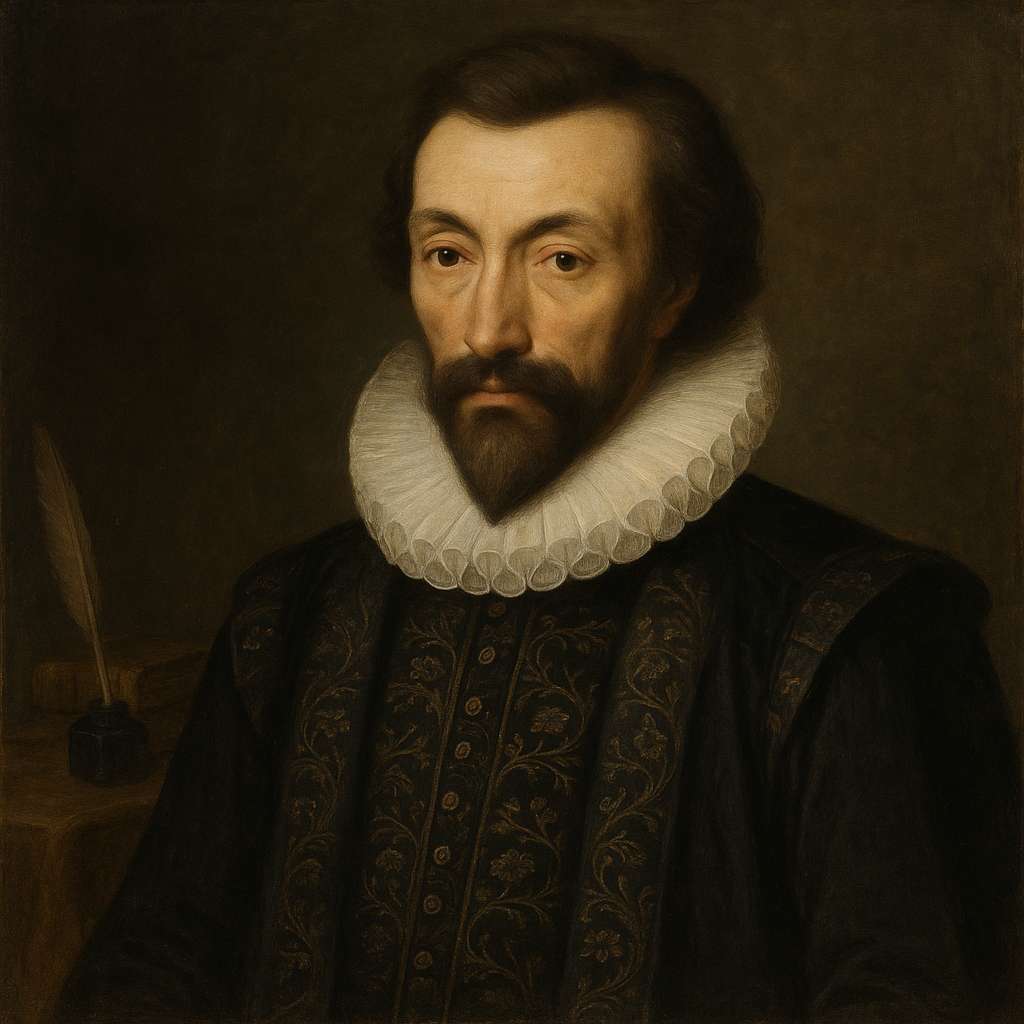Love's Growth
John Donne
1572 to 1631

I scarce beleeve my love to be so pure
As I had thought it was,
Because it doth endure
Vicissitude, and season, as the grasse;
Me thinkes I lyed all winter, when I swore,
My love was infinite, if spring make' it more.
But if this medicine, love, which cures all sorrow
With more, not onely bee no quintessence,
But mixt of all stuffes, paining soule, or sense,
And of the Sunne his working vigour borrow,
Love's not so pure, and abstract, as they use
To say, which have no Mistresse but their Muse,
But as all else, being elemented too,
Love sometimes would contemplate, sometimes do.
And yet no greater, but more eminent,
Love by the spring is growne;
As, in the firmament,
Starres by the Sunne are not inlarg'd, but showne.
Gentle love deeds, as blossomes on a bough,
From loves awakened root do bud out now.
If, as in water stir'd more circles bee
Produc'd by one, love such additions take,
Those like so many spheares, but one heaven make,
For, they are all concentrique unto thee.
And though each spring doe adde to love new heate,
As princes doe in times of action get
New taxes, and remit them not in peace,
No winter shall abate the springs encrease.
John Donne's Love's Growth
John Donne’s Love’s Growth is a metaphysical meditation on the nature of love, its mutability, and its capacity for expansion. Written in the early 17th century, the poem interrogates conventional Petrarchan ideals of love as static and unchanging, proposing instead that love is dynamic, subject to growth, and enriched by its very fluctuations. Donne’s characteristic intellectual rigor and vivid imagery transform what might seem a simple love poem into a philosophical inquiry. This essay explores the poem’s historical and cultural context, its intricate literary devices, its central themes, and its emotional resonance. Additionally, it considers Donne’s biographical influences, engages in comparative analysis with other metaphysical poets, and situates the poem within broader philosophical discourses on love.
Historical and Cultural Context
Donne wrote Love’s Growth during the late Renaissance, a period marked by intellectual upheaval, scientific discovery, and religious tension. The poem reflects the metaphysical poets’ preoccupation with blending emotion and intellect, as well as their tendency to challenge established poetic conventions. Unlike the Petrarchan sonneteers, who idealized love as eternal and unchanging, Donne presents love as something that evolves, much like the natural world.
The early 17th century also saw the rise of empirical science, with figures like Galileo and Kepler reshaping humanity’s understanding of the cosmos. Donne, who was deeply interested in astronomy and medicine, incorporates these influences into his poetry. The references to celestial bodies (“Starres by the Sunne”) and elemental mixtures (“mixt of all stuffes”) demonstrate his engagement with contemporary scientific thought. Furthermore, the poem’s focus on love’s endurance through “vicissitude” (change) aligns with Renaissance humanism, which emphasized lived experience over abstract ideals.
Literary Devices and Structure
Donne employs a range of literary devices to convey his complex vision of love.
1. Conceit and Extended Metaphor
The poem’s central conceit compares love to natural growth—grass flourishing in spring, blossoms budding from a tree. This metaphor serves two purposes: it challenges the notion of love as a fixed, Platonic ideal, and it suggests that love’s beauty lies in its organic development. The imagery of seasonal change (“winter,” “spring”) reinforces this idea, positioning love as cyclical rather than static.
2. Paradox and Logical Argumentation
Donne’s metaphysical style thrives on paradox. The speaker begins by doubting his love’s purity because it changes (“I scarce beleeve my love to be so pure / As I had thought it was”), yet concludes that this very mutability is evidence of its strength. The poem progresses like a logical proof, moving from uncertainty to affirmation.
3. Allusion and Intertextuality
The reference to the “quintessence” (a pure, fifth element in medieval alchemy) critiques the Neoplatonic ideal of love as an abstract, incorruptible force. Donne instead posits that love is “mixt of all stuffes,” implying that its richness comes from its impurities—its earthly, human dimensions.
4. Enjambment and Syntactic Complexity
The poem’s fluid syntax mirrors the idea of love’s expansion. Lines frequently spill into one another (“Because it doth endure / Vicissitude”), enacting the very growth the poem describes. This technique also creates a conversational tone, drawing the reader into the speaker’s reasoning.
Themes
1. Love as Dynamic and Expansive
The primary theme is love’s capacity to grow rather than diminish over time. Unlike traditional sonnets that lament love’s fading, Donne celebrates its increasing vigor. The comparison to celestial spheres (“so many spheares, but one heaven make”) suggests that love’s expansions do not dilute it but rather enrich its core.
2. The Interplay of Physical and Spiritual Love
Donne rejects the dichotomy between sacred and profane love. The lines “Love sometimes would contemplate, sometimes do” acknowledge both the intellectual and sensual aspects of love, refusing to privilege one over the other. This aligns with Donne’s broader rejection of Puritan asceticism in favor of a more holistic view of human experience.
3. Time and Mutability
The poem engages with the Renaissance anxiety over time’s passage. Yet, unlike Shakespeare’s sonnets, which often despair at time’s ravages, Donne’s speaker finds reassurance in love’s resilience: “No winter shall abate the springs encrease.” Here, time is not an enemy but a necessary condition for love’s maturation.
Emotional Impact
The poem’s emotional power lies in its reconciliation of doubt and certainty. The speaker begins with hesitation (“I scarce beleeve”) but arrives at a triumphant affirmation. This progression mirrors the experience of real love—fraught with questions, yet ultimately enduring. The final lines, with their imagery of unstoppable growth, leave the reader with a sense of optimism, suggesting that love, like nature, thrives through change rather than in spite of it.
Comparative Analysis
Donne’s treatment of love can be contrasted with that of his contemporaries. Where Petrarchan sonnets often depict love as a suffering (as in Sidney’s Astrophil and Stella), Donne presents it as a generative force. Similarly, while Shakespeare’s sonnets frequently fixate on preserving love against decay (e.g., Sonnet 18: “Nor shall Death brag thou wander’st in his shade”), Donne embraces love’s organic transformations.
A closer parallel exists with Andrew Marvell’s To His Coy Mistress, which also engages with time and love’s urgency. However, Marvell’s carpe diem approach contrasts with Donne’s more measured acceptance of love’s evolution.
Biographical and Philosophical Insights
Donne’s own life—marked by a passionate courtship, clandestine marriage, and eventual religious devotion—likely influenced his view of love as both earthly and transcendent. His earlier erotic poetry (The Flea, The Ecstasy) and later holy sonnets (Batter my heart) demonstrate a consistent preoccupation with love’s dual nature.
Philosophically, the poem resonates with Aristotle’s concept of potentiality and actuality—love is not a static form but a dynamic process. It also prefigures later Romantic ideas, particularly Wordsworth’s belief that “the child is father of the man”—growth does not negate earlier stages but fulfills them.
Conclusion
Love’s Growth is a masterful synthesis of intellect and emotion, blending scientific imagery, philosophical inquiry, and lyrical beauty. By rejecting the notion of love as an unchanging ideal, Donne presents a more nuanced and deeply human vision—one that acknowledges impermanence as the very source of love’s strength. The poem’s enduring appeal lies in its ability to articulate a truth both personal and universal: that love, like life itself, is most vital when it is allowed to grow.
In an age still grappling with the complexities of human connection, Donne’s insights remain strikingly relevant. His celebration of love’s resilience offers not just a poetic ideal but a lived philosophy—one that embraces change as the essence of enduring affection.
This text was generated by AI and is for reference only. Learn more
Want to join the discussion? Reopen or create a unique username to comment. No personal details required!



Comments
No comments yet. Be the first to comment!